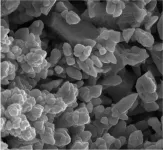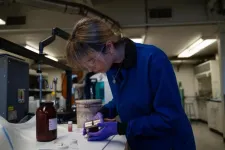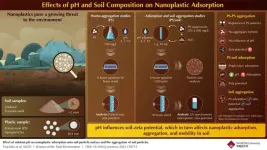Finding cancer’s ‘fingerprints’
2025-04-09
(Press-News.org) Cancer diagnoses traditionally require invasive or labor-intensive procedures such as tissue biopsies. Now, research published in ACS Central Science reveals a method that uses pulsed infrared light to identify molecular profiles in blood plasma that could indicate the presence of certain common cancers. In this proof-of-concept study, blood plasma from more than 2,000 people was analyzed to link molecular patterns to lung cancer, extrapolating a potential “cancer fingerprint.”
Plasma is the liquid portion of blood, depleted of any cells. It carries diverse molecules such as proteins, metabolites, lipids and salts throughout the body. Some molecules carried by blood plasma indicate potential health conditions. For example, unusually high levels of prostate-specific antigen are used to screen for prostate cancer. Theoretically, a medical test that measures a broad range of molecules could identify a pattern specific to different cancers, leading to quicker diagnoses and reduced costs. To look for telltale chemical patterns of cancer, Mihaela Žigman and colleagues tested a technique called electric-field molecular fingerprinting that uses pulsed infrared light to profile complex molecular mixtures in blood plasma.
First, the researchers used the electric-field molecular fingerprinting technique to send ultra-short bursts of infrared light through plasma. They analyzed samples from 2,533 study participants, including people with lung, prostate, breast or bladder cancer and those without cancer. For each sample, they recorded the pattern of light emitted by the molecular mixtures in the plasma — called an “infrared molecular fingerprint.”
Using these complex patterns from individuals with and without cancer, the researchers taught a machine learning model to identify molecular signatures associated with the four types of cancer. The computer model was tested on a separate subset of participants’ samples to see how well the model could perform on unseen test data. The analytical technique demonstrated a convincing level of accuracy (up to 81%) in detecting lung cancer-specific infrared signatures and differentiating them from control samples obtained from individuals without cancer. However, the computer model’s performance had lower success rates detecting the other three cancers. In the future, the researchers aim to expand and test the approach to identify additional cancer types and other health conditions.
"Laser-based infrared molecular fingerprinting detects cancer, demonstrating its potential for clinical diagnostics,” Žigman says. “With further technological developments and independent validation in sufficiently powered clinical studies, it could establish generalizable applications and translate into clinical practice — advancing the way we diagnose and screen for cancer today.”
The authors acknowledge support from the Ludwig Maximilian University of Munich Centre for Advanced Laser Applications (CALA) and the Researchers Supporting Project.
Some authors have filed a patent application for this technology.
The paper’s abstract will be available on April 9 at 8 a.m. Eastern time here: http://pubs.acs.org/doi/abs/10.1021/acscentsci.4c02164
###
The American Chemical Society (ACS) is a nonprofit organization chartered by the U.S. Congress. ACS’ mission is to advance the broader chemistry enterprise and its practitioners for the benefit of Earth and all its people. The Society is a global leader in promoting excellence in science education and providing access to chemistry-related information and research through its multiple research solutions, peer-reviewed journals, scientific conferences, e-books and weekly news periodical Chemical & Engineering News. ACS journals are among the most cited, most trusted and most read within the scientific literature; however, ACS itself does not conduct chemical research. As a leader in scientific information solutions, its CAS division partners with global innovators to accelerate breakthroughs by curating, connecting and analyzing the world’s scientific knowledge. ACS’ main offices are in Washington, D.C., and Columbus, Ohio.
Registered journalists can subscribe to the ACS journalist news portal on EurekAlert! to access embargoed and public science press releases. For media inquiries, contact newsroom@acs.org.
Note: ACS does not conduct research but publishes and publicizes peer-reviewed scientific studies.
Follow us: Facebook | LinkedIn | Instagram
END
ELSE PRESS RELEASES FROM THIS DATE:
2025-04-09
Wear and tear on plastic products releases small to nearly invisible plastic particles, which could impact people’s health when consumed or inhaled. To make these particles biodegradable, researchers created plastics from plant starch instead of petroleum. An initial study published in ACS’ Journal of Agricultural and Food Chemistry shows how animals consuming particles from this alternative material developed health problems such as liver damage and gut microbiome imbalances.
“Biodegradable starch-based plastics may not be as safe and health-promoting as originally assumed,” ...
2025-04-09
Iron and its alloys, such as steel and cast iron, dominate the modern world, and there’s growing demand for iron-derived products. Traditionally, blast furnaces transform iron ore into purified elemental metal, but the process requires a lot of energy and emits air pollution. Now, researchers in ACS Energy Letters report that they’ve developed a cleaner method to extract iron from a synthetic iron ore using electrochemistry, which they say could become cost-competitive with blast furnaces.
"Identifying oxides which can be converted to iron metal at low temperatures is an important ...
2025-04-09
University of Oregon chemists are bringing a greener way to make iron metal for steel production closer to reality, a step towards cleaning up an industry that’s one of the biggest contributors to carbon emissions worldwide.
Last year UO chemist Paul Kempler and his team reported a way to create iron with electrochemistry, using a series of chemical reactions that turn saltwater and iron oxide into pure iron metal.
In their latest work, they’ve optimized the starting materials for the process, identifying which kinds of iron oxides will make the chemical reactions the most cost-effective. That’s a key ...
2025-04-09
Plastics are everywhere—from packaging and textiles to electronics and medical devices. As plastic waste breaks down, it releases microscopic particles that can penetrate our ecosystems, hinder plant growth, and potentially transfer harmful pollutants to organisms, including humans. Therefore, these plastic particles are a potential threat to the ecosystem, especially in their nanoparticulate form (1–100 nm diameter), which can penetrate the environment through different routes, including the soil beneath our feet.
With this in mind, a team of researchers from Japan set out to study the migration behavior of nanoplastics ...
2025-04-09
Coupling reactions are among the most transformative tools in organic chemistry, enabling the formation of crucial chemical bonds in pharmaceuticals, agrochemicals, and advanced materials. Since their introduction, they have been one of the backbones of modern organic synthesis. However, these methods have long relied on environmentally taxing transition metal catalysts, such as palladium, which are often scarce, costly, and generate unwanted byproducts.
The limitations of conventional coupling methods have prompted researchers to seek alternative strategies that better align with the principles of green and sustainable chemistry ...
2025-04-09
Amid deepening inequalities and escalating crises, including climate change, biodiversity loss and pollution, a new United Nations report presents a bold approach for change.
The 2025 Interconnected Disaster Risks report, Turning Over a New Leaf, issued by the UN University’s Institute for Environment and Human Security (UNU-EHS), shifts focus from diagnosing problems to mapping out solutions. It establishes that many of today’s solutions are surface-level fixes, and that to create ...
2025-04-09
COLUMBUS, Ohio – Researchers at The Ohio State University Wexner Medical Center and College of Medicine have discovered a new way that neurons act in neurodegeneration by using human neural organoids – also known as “mini-brain” models – from patients with frontotemporal lobar degeneration (FTLD).
Understanding this new pathway could help researchers find better treatments for FTLD and Alzheimer’s, the two most common forms of dementia that lead to cognitive decline.
Researchers used advanced techniques to study neurons from ...
2025-04-09
A pivot from fossil fuels to clean energy technologies by 2060 would improve energy security and reduce trade risks for most nations, according to an April 9 study in Nature Climate Change.
Lithium, nickel, cobalt, copper, and rare earth minerals are among the prized materials for countries and corporations racing to secure supplies for energy systems that do not add greenhouse gases to our atmosphere. Unlike fossil fuels, natural reserves of these materials are most concentrated in the Global South, shuffling the geopolitics of energy and global trade.
“Most people ...
2025-04-09
New research from the University of Sydney has revealed poor oral health is significantly associated with higher instances of migraines, abdominal and body pain in women.
Published in Frontiers in Pain Research, the world-first study identified specific oral microbes correlated with certain pain conditions, suggesting a potential relationship between the oral microbiome and the nervous system.
The findings highlight the importance of good oral health to potentially mitigate pain and improve overall wellbeing, prompting further exploration into the role of oral microbiota in chronic unexplained ...
2025-04-09
A review published in The Laryngoscope indicates that climate change’s effects on pollen seasons and concentrations are contributing to increasing rates of allergic rhinitis, or hay fever.
When investigators assessed research published between 2000 and 2023, they identified 30 studies that reported on the current epidemiological state of allergic rhinitis, described factors related to climate change, and observed how global warming is affecting pollen seasons and allergy symptoms.
Sixteen studies reported longer pollen seasons and/or higher pollen concentrations related to climate change. As an example, total pollen emissions in the U.S. are projected to increase by 16–40% ...
LAST 30 PRESS RELEASES:
[Press-News.org] Finding cancer’s ‘fingerprints’





